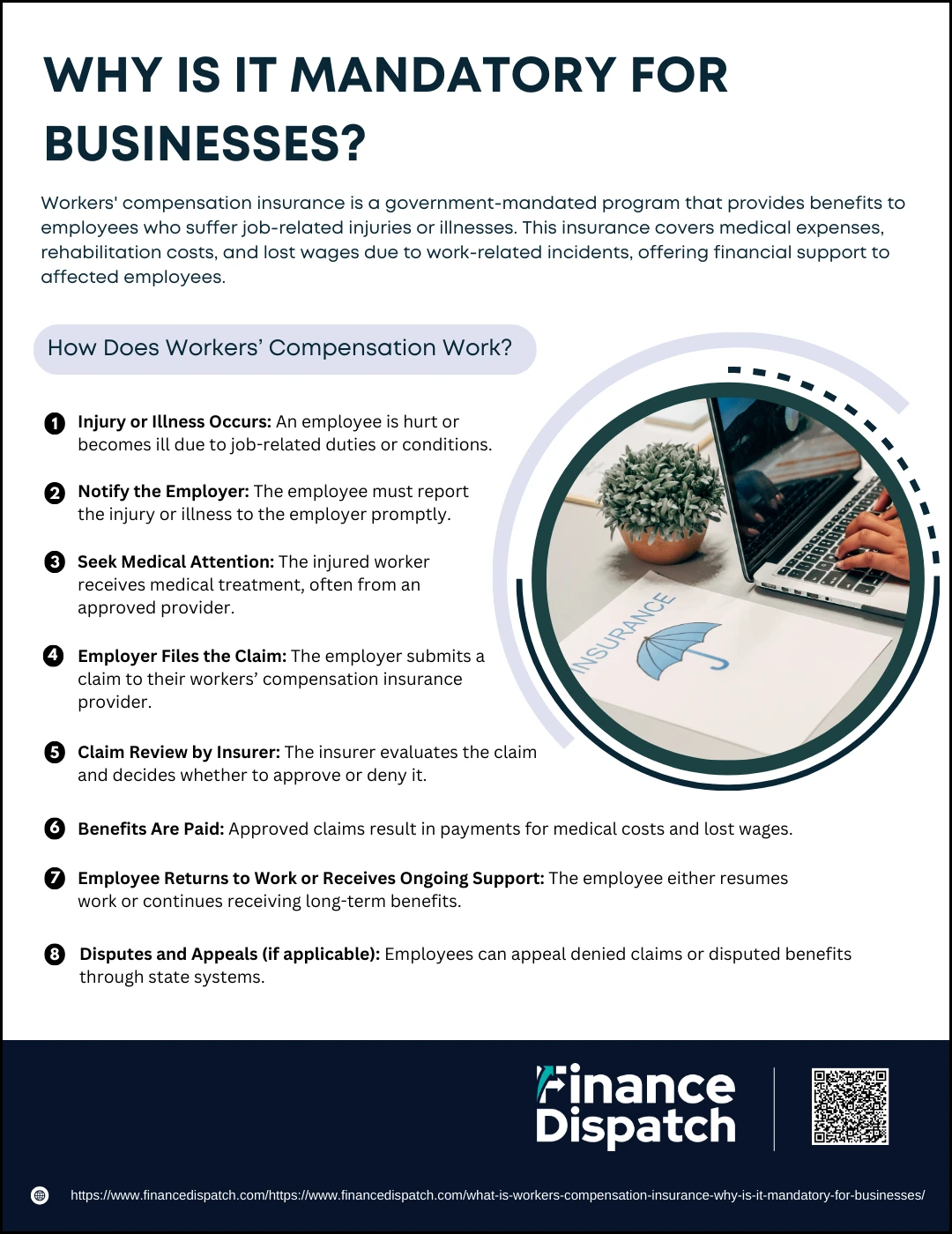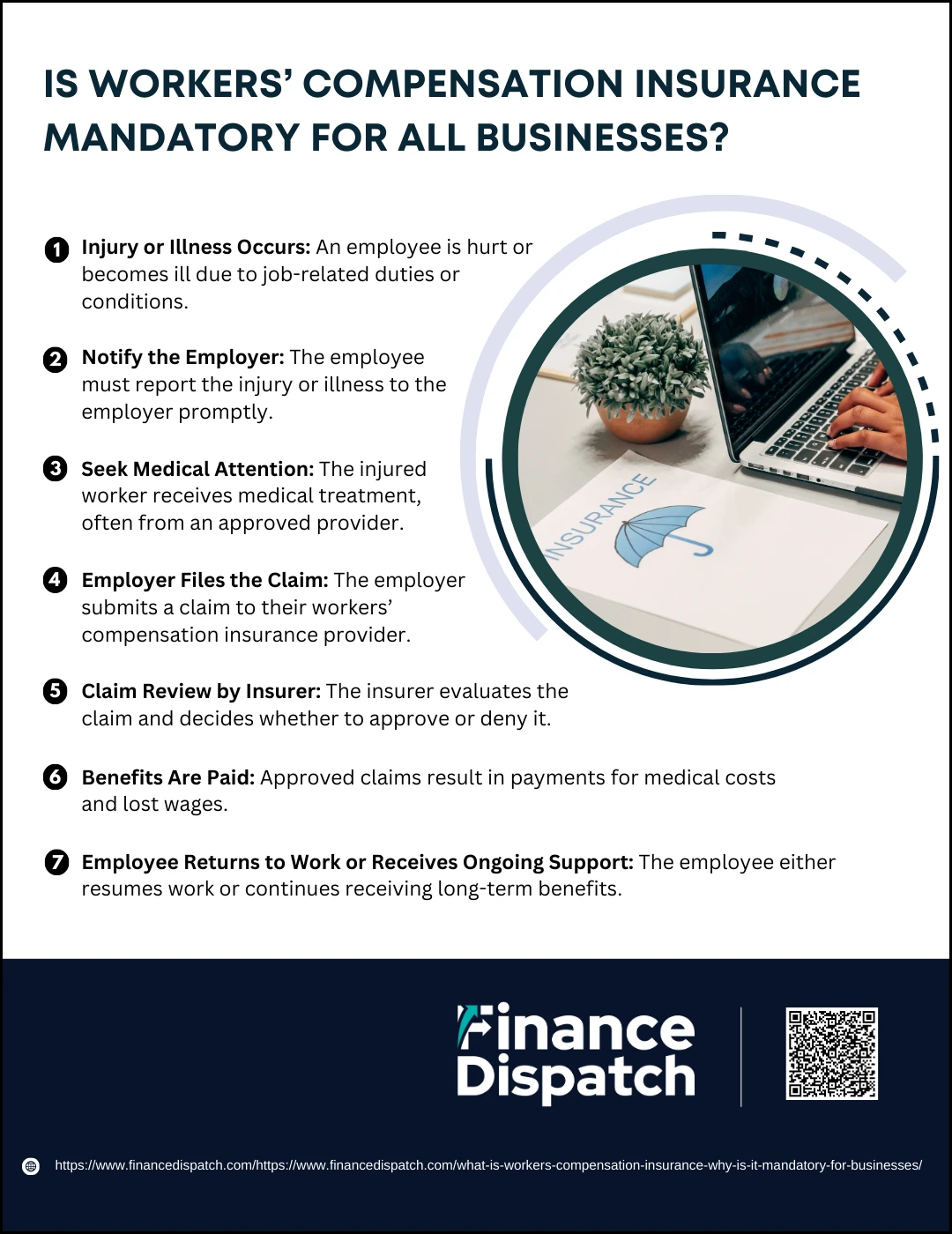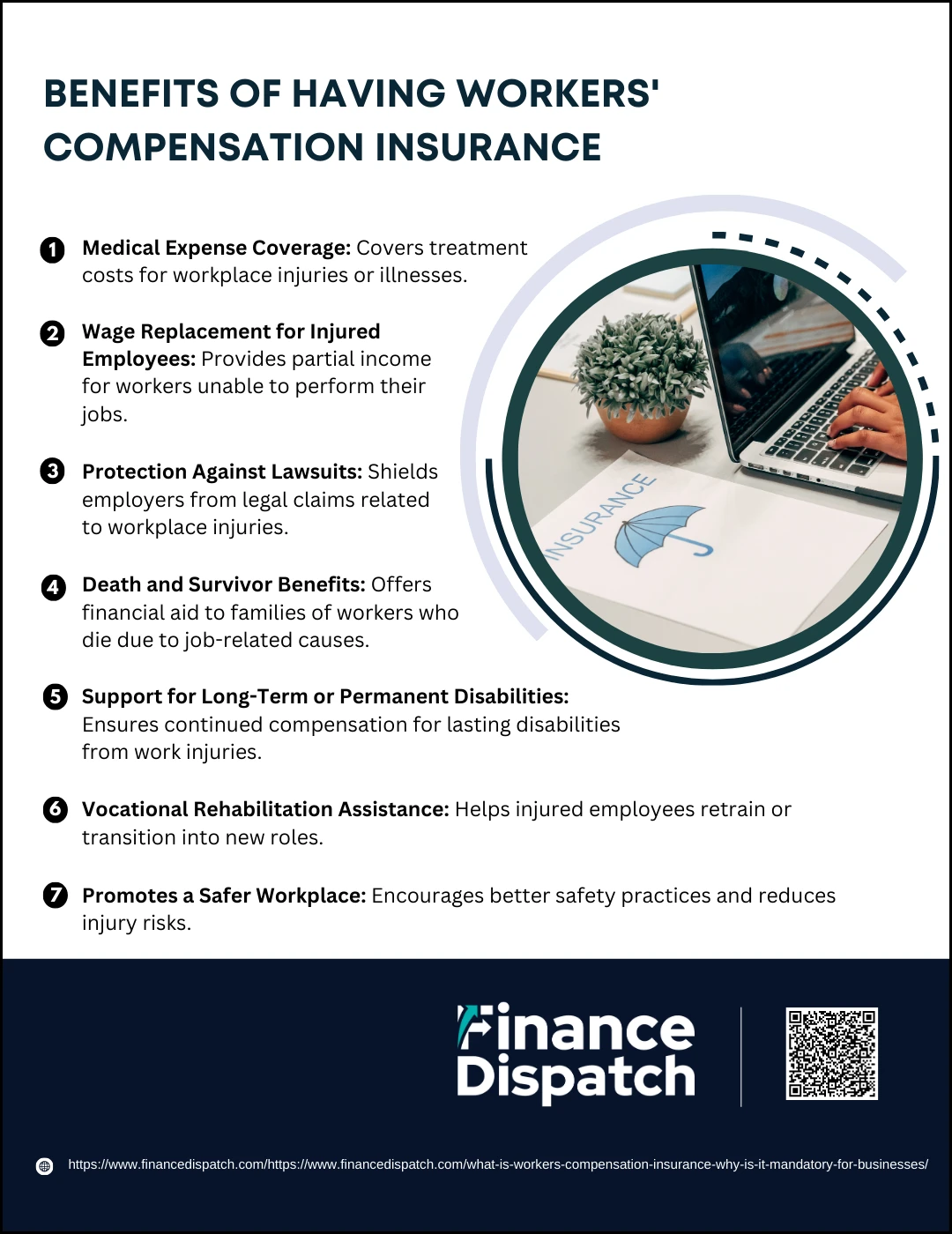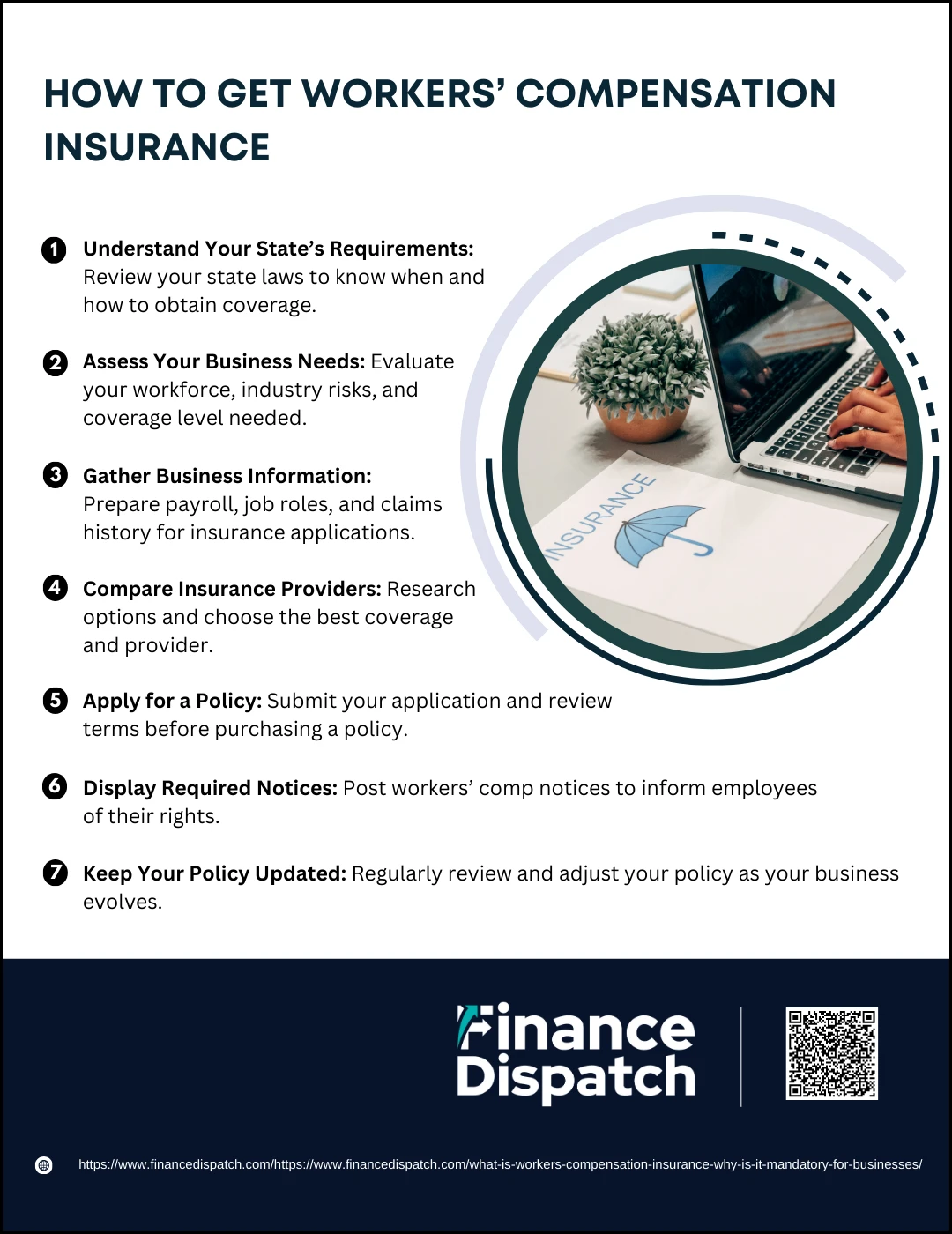Accidents and illnesses can happen in any workplace, no matter how safe or well-managed it may be. That’s where workers’ compensation insurance steps in. This essential form of coverage protects both employees and employers when work-related injuries or health issues arise. For workers, it ensures timely access to medical treatment, wage replacement, and other necessary support. For businesses, it offers legal protection and financial stability in the face of unexpected claims. In most states, carrying workers’ compensation insurance isn’t just a smart business move—it’s a legal requirement. This article explores what workers’ compensation insurance is, how it works, and why it’s a mandatory safeguard for modern businesses.
What is Workers’ Compensation Insurance?
Workers’ compensation insurance is a state-mandated coverage that provides financial and medical benefits to employees who suffer job-related injuries or illnesses. Often referred to as “workers’ comp,” this insurance helps cover expenses such as medical bills, rehabilitation costs, and a portion of lost wages during the recovery period. In cases where a worker experiences permanent disability or dies due to a workplace incident, it also offers long-term support or death benefits to their dependents. The system operates on a no-fault basis, meaning employees receive benefits regardless of who was responsible for the accident, and in return, they typically waive the right to sue their employer. This creates a balanced safety net that supports the workforce while protecting businesses from costly legal battles.
 How Does Workers’ Compensation Work?
How Does Workers’ Compensation Work?
Workers’ compensation is a vital safety net that helps both employees and employers navigate the aftermath of workplace injuries or illnesses. It ensures that workers receive the care and support they need while protecting businesses from the burden of legal claims. Although the specifics can vary slightly depending on the state, the overall process generally follows the same essential steps.
1. Injury or Illness Occurs
This is the starting point of any workers’ compensation case. An employee sustains an injury or contracts an illness while performing duties related to their job. This could be something immediate—like a slip and fall on a wet floor—or something that develops over time, such as repetitive strain injuries or occupational illnesses due to chemical exposure.
2. Notify the Employer
Timely notification is critical. Employees must inform their employer about the injury or illness as soon as possible, usually within a few days of the incident. Failure to report the issue within the legally required time frame could result in denial of the claim. It’s advisable to provide written notice and keep a copy for personal records.
3. Seek Medical Attention
The injured employee should get medical help immediately. In many states, employers or their insurance companies may require the worker to visit a specific healthcare provider or network. The attending doctor evaluates the injury, recommends treatment, and documents the medical condition, which plays a crucial role in the claims process.
4. Employer Files the Claim
After being notified, the employer is responsible for reporting the incident to their workers’ compensation insurance provider. This involves completing specific forms, describing the nature of the injury, and submitting the necessary documentation to initiate the claim.
5. Claim Review by Insurer
Once the insurance company receives the claim, it reviews the details, investigates if needed, and may ask for further information from the employer, employee, or medical provider. Based on this review, the insurer decides whether to approve or deny the claim.
6. Benefits Are Paid
If the claim is approved, the insurer starts paying benefits. These can include reimbursement for medical expenses, a portion of the employee’s lost wages (typically around two-thirds), and support for temporary or permanent disability. Payments are usually made on a weekly or biweekly basis, depending on state law and the insurer’s practices.
7. Employee Returns to Work or Receives Ongoing Support
Once the worker recovers enough to resume duties, they return to work—either in the same position or in a modified role if necessary. In cases of permanent disability, the employee may receive long-term benefits or vocational rehabilitation to help them transition into a new job that suits their abilities.
8. Disputes and Appeals (if applicable)
Sometimes, disputes arise over whether the injury is work-related, the severity of the injury, or the benefits amount. If the claim is denied, the employee has the right to appeal the decision through the state’s workers’ compensation board or court system. Hearings may be held, and additional evidence such as medical records or witness statements may be required to resolve the case.
Key Components of Workers’ Compensation
Workers’ compensation is more than just an insurance policy—it’s a comprehensive system designed to support employees and employers when workplace injuries or illnesses occur. At its core, it ensures injured workers get the care and financial help they need, while also protecting businesses from potential legal claims. Understanding the key components of workers’ compensation can help employers manage their responsibilities and ensure employees receive the benefits they’re entitled to.
Key Components Include:
1. Medical Benefits
Covers the cost of medical treatment related to a work injury or illness, including doctor visits, hospital stays, surgery, physical therapy, and prescription medications.
2. Wage Replacement
Provides a portion of the employee’s lost wages while they are unable to work due to injury or illness—typically around two-thirds of their regular earnings.
3. Disability Benefits
Offers financial support if the injury leads to a temporary or permanent disability. These are classified as temporary total, temporary partial, permanent total, or permanent partial disabilities.
4. Vocational Rehabilitation
Helps injured workers re-enter the workforce by funding retraining, education, or job placement services when they can no longer return to their original roles.
5. Death and Survivor Benefits
Provides compensation to the dependents of an employee who dies due to a work-related incident. This includes funeral expenses and ongoing financial support for surviving family members.
6. Employer’s Legal Protection
Shields employers from most lawsuits related to workplace injuries, as workers generally waive their right to sue in exchange for guaranteed benefits.
7. Claims Process and Administration
Involves the timely reporting, documentation, and review of claims, often overseen by the employer, insurance company, and state workers’ compensation board.
Why is Workers’ Compensation Insurance Important?
Workers’ compensation insurance plays a vital role in protecting both employees and employers when workplace injuries or illnesses occur. For employees, it ensures access to necessary medical treatment, income support during recovery, and long-term benefits in cases of disability or death. For employers, it provides a legal safeguard against costly lawsuits by offering a no-fault system where employees give up the right to sue in exchange for guaranteed benefits. This balance not only reduces financial strain on both sides but also fosters a safer, more secure work environment. Without this insurance, businesses could face significant legal and financial risks that could jeopardize their operations and employee trust.
 Is Workers’ Compensation Insurance Mandatory for All Businesses?
Is Workers’ Compensation Insurance Mandatory for All Businesses?
Workers’ compensation insurance is a legal requirement in most U.S. states, but it’s not universally mandatory for every business. Whether a business must carry coverage depends on several factors, including its size, structure, industry, and location. Understanding these requirements is essential for avoiding legal penalties and ensuring that both employers and employees are protected in case of a workplace injury. Here are the key factors that determine whether your business is legally required to carry workers’ compensation insurance:
1. State Law Requirements
Each state enforces its own workers’ compensation laws. Some states mandate coverage as soon as a business hires one employee, while others set the threshold at three, four, or five employees. Employers must comply with the laws in each state where they operate.
2. Number of Employees
In most states, having even one part-time or full-time employee can trigger the requirement for workers’ compensation. Some states exclude specific categories like family members or domestic workers from the employee count, so the rules can vary.
3. Business Structure
Sole proprietors, partners, and members of LLCs are typically not required to carry workers’ compensation for themselves. However, if they hire outside employees, they are usually required to provide coverage. Some business owners voluntarily opt into coverage to protect themselves.
4. Type of Work Performed
Certain industries—such as construction, transportation, and manufacturing—pose higher risks to workers and are therefore subject to stricter regulations. In these sectors, coverage is often mandatory regardless of how many workers are employed.
5. Independent Contractors
Generally, independent contractors are not covered under a business’s workers’ comp policy. However, if a contractor is injured and later deemed an employee by the state, the business may be held liable. Misclassification can result in audits, fines, and lawsuits.
6. State-Specific Exemptions
Some states allow exemptions for particular types of workers. For example, agricultural workers, casual laborers, and real estate agents working on commission may be exempt in certain jurisdictions. Business owners should review their state’s exemptions carefully.
7. Exceptions (e.g., Texas)
Texas stands out as the only state that does not require private employers to carry workers’ compensation insurance. However, companies that opt out (known as “non-subscribers”) risk being sued directly by injured employees and may be held liable for full damages.
 Benefits of Having Workers’ Compensation Insurance
Benefits of Having Workers’ Compensation Insurance
Workers’ compensation insurance offers vital protection for both employers and employees when workplace injuries or illnesses occur. While it is often a legal obligation, the true value of this coverage goes beyond compliance. It provides financial security, ensures timely medical care, and promotes a safer, more productive work environment. Below are the key benefits in greater detail:
1. Medical Expense Coverage
One of the core benefits of workers’ comp is covering the full cost of medical treatment for injuries or illnesses that happen on the job. This includes emergency care, doctor visits, surgery, hospitalization, prescription medications, and long-term therapies like physical or occupational rehab—ensuring that employees can recover without bearing the financial burden themselves.
2. Wage Replacement for Injured Employees
When an injury prevents an employee from working, workers’ compensation provides wage replacement benefits—usually about two-thirds of their regular earnings. This financial support helps employees manage their bills and basic living expenses while focusing on recovery, reducing stress during a difficult time.
3. Protection Against Lawsuits
Workers’ compensation is a no-fault system, meaning employees typically waive their right to sue their employer in exchange for guaranteed benefits. This helps businesses avoid costly litigation, legal fees, and settlements that could otherwise arise from workplace injury claims.
4. Death and Survivor Benefits
If a work-related accident results in death, the policy provides death benefits to the employee’s family. These benefits often include funeral expenses and ongoing financial support to help the deceased worker’s dependents cope with the sudden loss of income.
5. Support for Long-Term or Permanent Disabilities
When an injury leads to a long-term or permanent disability, workers’ comp ensures continued financial assistance. Whether it’s a partial or total disability, the injured worker receives benefits based on the severity and permanence of their condition—helping them maintain financial stability for the long term.
6. Vocational Rehabilitation Assistance
If an injured employee can’t return to their previous job, workers’ comp may cover vocational rehabilitation. This includes job retraining, career counseling, educational programs, and job placement services to help them transition into a new role that accommodates their limitations.
7. Promotes a Safer Workplace
Having workers’ compensation in place encourages businesses to adopt better safety measures and training programs to minimize risks. A safer workplace not only reduces the number of claims but also boosts employee morale and trust, ultimately improving productivity.
What Happens If a Business Doesn’t Have It?
Operating without workers’ compensation insurance can lead to serious legal and financial consequences for a business. In most states, it’s a legal requirement—and failure to comply can result in hefty fines, criminal charges, and even forced business closure. If an employee is injured on the job and the business lacks coverage, the employer may be held personally responsible for all related medical expenses, lost wages, and potential legal settlements. This not only puts the company’s finances at risk but also its reputation and ability to operate legally. In some cases, a single uncovered injury claim could be enough to bankrupt a small business.
Real-World Examples of Workers’ Compensation Insurance
To truly understand the value of workers’ compensation insurance, it’s helpful to look at how it works in real-life situations. These examples highlight different workplace incidents where workers’ comp plays a critical role in protecting both the employee and the employer. From physical injuries to long-term disabilities, the following cases illustrate how this coverage provides financial support, medical care, and legal protection when it’s needed most.
Examples of Workers’ Compensation in Action
| Scenario | Incident Description | Outcome with Workers’ Comp Insurance |
| Construction Site Injury | A worker falls from scaffolding and breaks his leg. | Medical bills and surgery costs covered; receives wage replacement during recovery. |
| Repetitive Strain Injury | An office employee develops carpal tunnel syndrome from prolonged computer use. | Treatment and physical therapy covered; employer avoids lawsuit. |
| Delivery Driver Accident | A delivery driver is involved in a car accident while on duty. | Emergency care and rehab covered; receives benefits for lost income. |
| Chemical Exposure | A lab technician becomes ill from repeated chemical exposure. | Long-term treatment covered; vocational retraining provided for safer role. |
| Fatal Workplace Accident | A factory worker dies in a machinery-related accident. | Funeral costs paid; surviving spouse and children receive death benefits. |
| Slip and Fall in Restaurant | A kitchen worker slips on a wet floor and injures their back. | Medical costs covered; short-term disability benefits issued. |
 How to Get Workers’ Compensation Insurance
How to Get Workers’ Compensation Insurance
Securing workers’ compensation insurance is a crucial step in protecting your business and employees from the unexpected costs of workplace injuries or illnesses. While the exact process can vary slightly by state, getting coverage typically involves evaluating your business needs, understanding legal requirements, and working with the right provider. Here’s a simple guide to help you navigate the process.
Steps to Get Workers’ Compensation Insurance
1. Understand Your State’s Requirements
Start by checking your state’s laws regarding workers’ compensation. Each state has different rules about when coverage is required, who needs to be covered, and how to obtain a policy.
2. Assess Your Business Needs
Review the number of employees you have, the nature of your industry, and your company’s risk exposure. High-risk jobs typically require more comprehensive coverage and may carry higher premiums.
3. Gather Business Information
Insurance providers will need specific details such as your total payroll, number of employees, job descriptions, and claims history (if any). Having this information ready helps speed up the process.
4. Compare Insurance Providers
You can buy workers’ compensation insurance through a private insurance company, a state-run fund, or an assigned risk pool if you’re unable to get standard coverage. Compare quotes, coverage options, and customer service ratings.
5. Apply for a Policy
Once you’ve chosen a provider, complete the application process. This may include a phone interview, online forms, or meeting with an agent. Be sure to review the terms carefully before finalizing the purchase.
6. Display Required Notices
After getting coverage, most states require you to post a workers’ compensation notice in a visible area of your workplace to inform employees of their rights and how to file a claim.
7. Keep Your Policy Updated
Review your policy annually or when your business changes (such as hiring more staff or expanding services). Keeping it up to date ensures ongoing compliance and proper protection.
Conclusion
Workers’ compensation insurance is more than a regulatory requirement—it’s a critical layer of protection that supports both employees and employers in times of need. From covering medical expenses and lost wages to shielding businesses from costly lawsuits, this insurance plays a vital role in maintaining workplace stability and financial security. Whether you’re a small business owner or managing a large workforce, having a proper workers’ compensation policy in place demonstrates your commitment to safety, responsibility, and long-term success. By understanding how it works, why it’s mandatory, and how to secure the right coverage, you can build a safer and more resilient business for the future.



